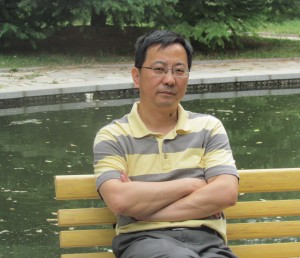 Hanying Zhao received his bachelor’s degree in Chemical Engineering from HeFei University of Technology in China in 1988, his MS degree in Chemical Engineering from Tianjin University in 1993, and a PhD in Polymer Chemistry and Physics from Changchun Institute of Applied Chemistry, Chinese Academy of Sciences in 1997. From 1997 to 2004, he conducted postdoctoral research in Fudan University, Institute of Polymer Research in Dresden, University of Florida and Clarkson University. He joined the Department of Chemistry at Nankai University in 2004, and now he is a professor of chemistry. His current research interests include: (1) synthesis and self-assembly of macromolecules with different topological structures, (2) synthesis of polymer brushes on solid surfaces, (3) synthesis and self-assembly of shape amphiphiles (gold nanoparticles, single-chain nanoparticles, Janus structures).
Hanying Zhao received his bachelor’s degree in Chemical Engineering from HeFei University of Technology in China in 1988, his MS degree in Chemical Engineering from Tianjin University in 1993, and a PhD in Polymer Chemistry and Physics from Changchun Institute of Applied Chemistry, Chinese Academy of Sciences in 1997. From 1997 to 2004, he conducted postdoctoral research in Fudan University, Institute of Polymer Research in Dresden, University of Florida and Clarkson University. He joined the Department of Chemistry at Nankai University in 2004, and now he is a professor of chemistry. His current research interests include: (1) synthesis and self-assembly of macromolecules with different topological structures, (2) synthesis of polymer brushes on solid surfaces, (3) synthesis and self-assembly of shape amphiphiles (gold nanoparticles, single-chain nanoparticles, Janus structures).
Webpage: http://chem.nankai.edu.cn/teachers/echo-1.php?id=zhaohanying
What was your inspiration in becoming a chemist?
Actually, until I received my master degree, I was not sure what job I should take, to be a chemist or an engineer? I thought it was not a bad thing to have a PhD degree, so I went to Changchun to pursue my PhD. I studied under Professor Baotong Huang at Changchun Institute of Applied Chemistry, Chinese Academy of Sciences. Prof. Huang was an eminent polymer chemist at that time. In my research, I synthesized block copolymers by anionic polymerization, I found polymer chemistry is so beautiful and I never left this field since then. Now all the research conducted in our group is related to polymer chemistry.
What was the motivation to write your Polymer Chemistry article? (DOI: 10.1039/C3PY00516J)
Usually polymeric micelles are composed of hydrophobic cores and hydrophilic coronae. The hydrophobic cores can be used as nanosized vehicles for hydrophobic compounds. In our article, we described a method to prepare hydrophilic interface-crosslinked polymeric micelles. The interfaces of the micelles are crosslinked by atom transfer radical coupling reaction, and the stability of the micelles is improved. The cores and the coronae of the micelles are hydrophilic, and the hydrophilic micelles can be used as nanoreactors for the synthesis of CdS quantum dots, and nanocarriers for the absorption of methylene blue, a positively charged dye. In comparison to the traditional polymer micelles, the hydrophilic micelles may find broader applications in aqueous solutions.
Why did you choose Polymer Chemistry to publish your work? )
Polymer Chemistry is a leading journal in the fields of polymer science and polymer materials. We believe that publishing our paper in this journal can help the paper to be read by a broad scope of readers. Another reason is the rapid review process.
In which upcoming conferences may our readers meet you?
I will probably attend the Fall 2014 ACS meeting.
How do you spend your spare time?
In my spare time, I usually play badminton with my students. I enjoy reading history books.
Which profession would you choose if you were not a scientist?
I love science. I guess, if I were not a scientist, I would be a teacher in a middle-school, or a doctor in a hospital.
To keep up-to-date with all the latest research, sign-up to our RSS feed or Table of contents alert.











